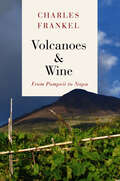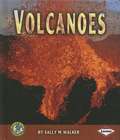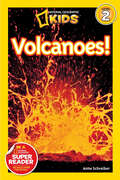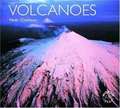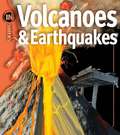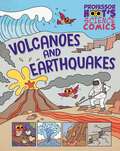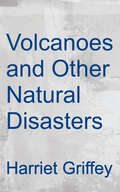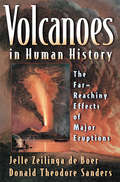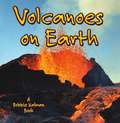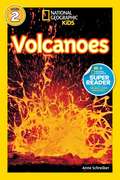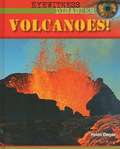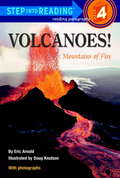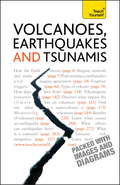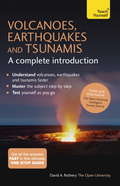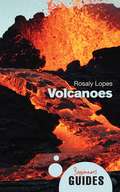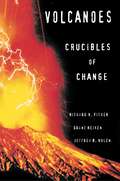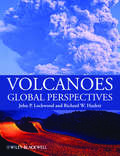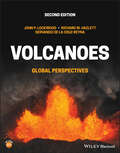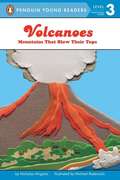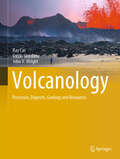- Table View
- List View
Volcanoes & Wine: From Pompeii to Napa
by Charles FrankelThere’s a reason we pay top dollar for champagne and that bottles of wine from prestige vineyards cost as much as a car: a place’s distinct geographical attributes, known as terroir to wine buffs, determine the unique profile of a wine—and some rarer locales produce wines that are particularly coveted. In Volcanoes and Wine, geologist Charles Frankel introduces us to the volcanoes that are among the most dramatic and ideal landscapes for wine making. Traveling across regions wellknown to wine lovers like Sicily, Oregon, and California, as well as the less familiar places, such as the Canary Islands, Frankel gives an in-depth account of famous volcanoes and the wines that spring from their idiosyncratic soils. From Santorini’s vineyards of rocky pumice dating back to a four-thousand-year-old eruption to grapes growing in craters dug in the earth of the Canary Islands, from Vesuvius’s famous Lacryma Christi to the ambitious new generation of wine growers reviving the traditional grapes of Mount Etna, Frankel takes us across the stunning and dangerous world of volcanic wines. He details each volcano’s most famous eruptions, the grapes that grow in its soils, and the people who make their homes on its slopes, adapting to an ever-menacing landscape. In addition to introducing the history and geology of these volcanoes, Frankel's book serves as a travel guide, offering a host of tips ranging from prominent vineyards to visit to scenic hikes in each location. This illuminating guide will be indispensable for wine lovers looking to learn more about volcanic terroirs, as well as anyone curious about how cultural heritage can survive and thrive in the shadow of geological danger.
Volcanoes (Early Bird Earth Science)
by Sally M. WalkerThis book introduces young readers to volcanoes--what they are, how they form, and how they affect people.
Volcanoes (Readers)
by Anne SchreiberThe cool story of volcanoes will intrigue kids and adults alike. Hot melted rock from the middle of our planet forces its way up through cracks in the Earth&’s crusts, exploding violently and sometimes unexpectedly in volcanic fury that can terrorize populations for months, even years. Anne Schreiber&’s narrative gives readers a little of the science, a little of the history, and a lot of the action. National Geographic photography fires the imagination on dramatic spreads alive with vivid images of lava, ash, molten rock, weird rocks, and steaming seawater.
Volcanoes (Worldlife Library)
by Peter ClarksonWhat are volcanoes? Where and why do they happen? The aim of this book is to answer these questions and to explain one of the great natural wonders of the Earth. Volcano! Just the mention of the word creates a mental picture, which varies with the listener's own perception. An artist may think of the classical shape of Mount Fuji; a historian may recall the destruction of Pompeii by Vesuvius; a geologist may speculate about the gas content of the lava in relation to its viscosity; a newspaper editor may see the scope for spectacular photographs and stories of human suffering and heroism that will boost newspaper circulation. Whatever thoughts spring to mind, nobody can be but impressed by the awful power of a volcanic eruption and the devastation that may be caused.
Volcanoes And Earthquakes (INsiders)
by Ken RubinINsiders brings volcanoes & earthquakes to life, with the most up-to-date information stimulating minds and imaginations in a whole new way.
Volcanoes and Earthquakes
by Mary EltingDiscusses how earthquakes and volcanic eruptions occur and how they can be predicted.
Volcanoes and Earthquakes (Professor Hoot's Science Comics #4)
by Jen GreenEvery day brings a new adventure for Professor Hoot - and a new learning experience. There's a plume of smoke in the distance, it looks like a volcano has erupted! Professor Hoot sets off to investigate all about volcanoes and how they are formed, all while avoiding smoky feathers! Discover other natural distasters, such as earthquakes, tsunamis and landslides - and what to do in such events.An entertaining comic strip approach to KS1 science topics, Professor Hoot's Science Comics are accessible and full of fun. Each book is an adventure and a chance for readers to learn something new, before testing their knowledge at the end of each book in Professor Hoot's quiz. Collect each adventure: Big Machines; Dangerous Animals; Dinosaurs; Robots and AI; Space; Volcanoes and Earthquakes.
Volcanoes and Geysers (Rigby PM Plus Non Fiction Ruby (Levels 27-28), Fountas & Pinnell Select Collections Grade 3 Level Q)
by Mary DraperThis text introduces children to volcanoes and volcanic activity. It also describes the effect of volcanic activity upon the environment. Other text forms include diagrams, explanations and a newspaper report.
Volcanoes and Other Natural Disasters (Dk Readers Series Dorling Kindersley Readers)
by Dorling Kindersley Publishing Staff Harriet GriffeyDescribes natural disasters which have occurred in various places throughout the world including the eruption of Vesuvius in 79 A.D., the Yellow River flood in 1887, and the Australian bush fires in 1983.
Volcanoes in Human History
by Jelle Zeilinga de Boer Donald Theodore Sanders Robert D. BallardWhen the volcano Tambora erupted in Indonesia in 1815, as many as 100,000 people perished as a result of the blast and an ensuing famine caused by the destruction of rice fields on Sumbawa and neighboring islands. Gases and dust particles ejected into the atmosphere changed weather patterns around the world, resulting in the infamous ''year without a summer'' in North America, food riots in Europe, and a widespread cholera epidemic. And the gloomy weather inspired Mary Shelley to write the gothic novel Frankenstein.This book tells the story of nine such epic volcanic events, explaining the related geology for the general reader and exploring the myriad ways in which the earth's volcanism has affected human history. Zeilinga de Boer and Sanders describe in depth how volcanic activity has had long-lasting effects on societies, cultures, and the environment. After introducing the origins and mechanisms of volcanism, the authors draw on ancient as well as modern accounts--from folklore to poetry and from philosophy to literature. Beginning with the Bronze Age eruption that caused the demise of Minoan Crete, the book tells the human and geological stories of eruptions of such volcanoes as Vesuvius, Krakatau, Mount Pelée, and Tristan da Cunha. Along the way, it shows how volcanism shaped religion in Hawaii, permeated Icelandic mythology and literature, caused widespread population migrations, and spurred scientific discovery.From the prodigious eruption of Thera more than 3,600 years ago to the relative burp of Mount St. Helens in 1980, the results of volcanism attest to the enduring connections between geology and human destiny.
Volcanoes of the Azores (Active Volcanoes of the World)
by Ulrich Kueppers Christoph BeierThe Azores archipelago consists of nine islands that emerge from the Azores Plateau in the Central Northern Atlantic, situated within the triple junction of the American, Eurasian and African lithosphere plates. Subaerial volcanic activity has been well known since the Pliocene and continues today, with several well-documented eruptions since the settlement of the islands in the fifteenth century. The origin of the Azores Plateau has been a matter of scientific debate and thus this book provides the first comprehensive overview of geological features in the Azores from volcanological, geochemical, petrological, paleontological, structural and hydrological perspectives
Volcanoes on Earth
by Bobbie KalmanDramatic photographs of spewing and flowing lava will capture the attention of any child. in this fantastic new book, children will be excited to learn what a volcano is and what makes it erupt. Simple explanations describe the different kinds of volcanoes, including cinder, cone-shaped, shield, and composite as well as the different kinds of lava and the land formations they create on land and under the ocean. Other topics include the reason volcanoes often erupt during earthquakes, why giant tsunami waves are sometimes created by underwater earthquakes, and how volcanoes are studied in order to predict and prepare for eruptions. Children will also enjoy making their own volcano out of household materials.
Volcanoes!
by Anne SchreiberThe cool story of volcanoes will intrigue kids and adults alike. Hot melted rock from the middle of our planet forces its way up through cracks in the Earth’s crusts, exploding violently and sometimes unexpectedly in volcanic fury that can terrorize populations for months, even years. Anne Schreiber’s narrative gives readers a little of the science, a little of the history, and a lot of the action.
Volcanoes!
by Helen DwyerProduces the facts on volcanoes, like what is a volcano, where they are found, and basic information on the same
Volcanoes!: Mountains of Fire (Step into Reading)
by Eric ArnoldA volcano could be called a sleeping mountain--that is, until it wakes up! What is it like to witness the eruption of one of nature's majestic time bombs? Young readers can learn what makes volcanoes "tick," and read about some of the most famous eruptions in history.
Volcanoes, Earthquakes And Tsunamis: Teach Yourself
by David RotheryVolcanoes, Earthquakes and Tsunamis is the essential guide to what causes the most frightening geological events with which we are faced today. It covers plate tectonics, the intricacies of each terrible phenomina, and their effects as well as the impact they have on each other, how they can be predicted and, if possible, controlled.NOT GOT MUCH TIME?One, five and ten-minute introductions to key principles to get you started.AUTHOR INSIGHTSLots of instant help with common problems and quick tips for success, based on the author's many years of experience.EXTEND YOUR KNOWLEDGEExtra online articles at www.teachyourself.com to give you a richer understanding.THINGS TO REMEMBERQuick refreshers to help you remember the key facts.
Volcanoes, Earthquakes and Tsunamis: A Complete Introduction: Teach Yourself
by David RotheryHow do volcanoes erupt, what makes earthquakes so destructive, and why do tsunamis happen?Volcanoes, Earthquakes and Tsunamis answers these questions and more, giving you everything you need to know about these powerful natural phenomena. It covers the plate tectonic background to Earth processes, where magma is made and how it erupts, volcano types, eruption hazards and how they are monitored, faults and earthquakes, the causes of tsunamis and tsunami preparedness. You will examine many examples of these frightening events, find out to what extent they can be predicted and mitigated against, and come to realize how they are related and the impact they have on human society and the natural world.Written by Dr David Rothery, a volcanologist, geologist, planetary scientist and Professor of Planetary Geosciences at the Open University, Volcanoes, Earthquakes and Tsunamis: A Complete Introduction is designed to give you everything you need to know, all in one place. It covers the key areas that students are expected to be confident in, outlining the basics in clear English and providing added-value features like a glossary of essential terms and even examples of questions you might be asked in your seminar or exam.The book covers the essentials of most university courses, with an introduction on how the Earth moves, followed by separate sections on volcanoes (including eruptions, types of volcano, volcanic hazards, volcanoes and climate, monitoring volcanoes, predicting eruptions and living with volcanoes), earthquakes (including faults, measurement, seismic monitoring, prediction, prevention and preparedness) and tsunamis.The colour plates referred to in the book can be downloaded from the Teach Yourself online library or accessed through the Teach Yourself Library app.
Volcanoes, Earthquakes and Tsunamis: Teach Yourself
by David RotheryWritten by Dr David Rothery, a volcanologist, geologist, planetary scientist and Professor of Planetary Geosciences at the Open University, Volcanoes, Earthquakes and Tsunamis: A Complete Introduction is designed to give you everything you need to succeed, all in one place. It covers the key areas that students are expected to be confident in, outlining the basics in clear English and providing added-value features like a glossary of essential terms and even examples of questions you might be asked in your seminar or exam.The book uses a structure chosen to cover the essentials of most university courses, with an introduction on how the Earth moves, followed by separate sections on volcanoes (including eruptions, types of volcano, volcanic hazards, volcanoes and climate, monitoring volcanoes, predicting eruptions and living with volcanoes), earthquakes (including faults, measurement, seismic monitoring, prediction, prevention and preparedness) and tsunamis.
Volcanoes: A Beginner's Guide (Beginner's Guides)
by Rosaly LopesWhether worshiped, feared, or studied, volcanoes have always been a subject of fascination and awe. Lopes explains the importance of volcanoes in shaping worlds, the dangers of volcanic eruptions, and some of the best places in the world to see eruptions, as well as including famous "case histories". Dr Rosaly Lopes is a Principal Scientist at NASA's Jet Propulsion Laboratory, where she is also Lead Scientist for Geophysics and Planetary Geosciences. She was honoured in the 2006 edition of the Guinness Book of World Records as the discoverer of the most active volcanoes anywhere.
Volcanoes: Crucibles of Change
by Grant Heiken Richard V. Fisher Jeffrey HulenWhenever a volcano threatens to erupt, scientists and adventurers from around the world flock to the site in response to the irresistible allure of one of nature's most dangerous and unpredictable phenomena. In a unique book probing the science and mystery of these fiery features, the authors chronicle not only their geologic behavior but also their profound effect on human life. From Mount Vesuvius to Mount St. Helens, the book covers the surprisingly large variety of volcanoes, the subtle to conspicuous signs preceding their eruptions, and their far-reaching atmospheric consequences. Here scientific facts take on a very human dimension, as the authors draw upon actual encounters with volcanoes, often through firsthand accounts of those who have witnessed eruptions and miraculously survived the aftermath. The book begins with a description of the lethal May 1980 eruption of Mount St. Helens--complete with an explanation of how safety officials and scientists tried to predict events, and how unsuspecting campers and loggers miles away struggled against terrifying blasts of ash, stone, and heat. The story moves quickly to the ways volcanoes have enhanced our lives, creating mineral-rich land, clean thermal energy, and haunting landscapes that in turn benefit agriculture, recreation, mining, and commerce. Religion and psychology embroider the account, as the authors explore the impact of volcanoes on the human psyche through tales of the capricious volcano gods and attempts to appease them, ranging from simple homage to horrific ritual sacrifice. Volcanoes concludes by assisting readers in experiencing these geological phenomena for themselves. An unprecedented "tourist guide to volcanoes" outlines over forty sites throughout the world. Not only will travelers find information on where to go and how to get there, they will also learn what precautions to take at each volcano. Tourists, amateur naturalists, and armchair travelers alike will find their scientific curiosity whetted by this informative and entertaining book.
Volcanoes: Global Perspectives
by Richard W. Hazlett John P. LockwoodVolcanoes are essential elements in the delicate global balance of elemental forces that govern both the dynamic evolution of the Earth and the nature of Life itself. Without volcanic activity, life as we know it would not exist on our planet. Although beautiful to behold, volcanoes are also potentially destructive, and understanding their nature is critical to prevent major loss of life in the future. Richly illustrated with over 300 original color photographs and diagrams the book is written in an informal manner, with minimum use of jargon, and relies heavily on first-person, eye-witness accounts of eruptive activity at both "red" (effusive) and "grey" (explosive) volcanoes to illustrate the full spectrum of volcanic processes and their products. Decades of teaching in university classrooms and fieldwork on active volcanoes throughout the world have provided the authors with unique experiences that they have distilled into a highly readable textbook of lasting value. Questions for Thought, Study, and Discussion, Suggestions for Further Reading, and a comprehensive list of source references make this work a major resource for further study of volcanology. Volcanoes maintains three core foci: Global perspectives explain volcanoes in terms of their tectonic positions on Earth and their roles in earth history Environmental perspectives describe the essential role of volcanism in the moderation of terrestrial climate and atmosphere Humanitarian perspectives discuss the major influences of volcanoes on human societies. This latter is especially important as resource scarcities and environmental issues loom over our world, and as increasing numbers of people are threatened by volcanic hazards Readership Volcanologists, advanced undergraduate, and graduate students in earth science and related degree courses, and volcano enthusiasts worldwide. A companion website is also available for this title at www.wiley.com/go/lockwood/volcanoes
Volcanoes: Global Perspectives
by Richard W. Hazlett John P. Lockwood Servando de la Cruz-ReynaVOLCANOES Since the publication of the first edition of Volcanoes in 2010, our world of volcanology has changed in exciting ways. Volcanoes have continued to erupt (some 61 eruptions with VEI magnitudes greater than 3 have taken place since 2010), and in this revised and updated edition, the authors describe the largest of these, and the ones that have had the most impact on society. Volcanoes, Second Edition, contains more than 80 new photographs and figures to better illustrate volcanic features and processes, with an updated Bibliography that includes important papers describing recent eruptions and new findings. Volcanologic research is improving the foundations of knowledge upon which all our science rests, and we briefly summarize the most important of these advances and new research tools developed over the past eleven years. The most productive of these new tools are remotely operated, constantly monitoring volcanoes and their impacts on the Earth’s atmosphere from space and exploring new volcanic worlds beyond the bounds of Earth. Remotely Operated Vehicles (ROVs) are now widely available to understand better the most active volcanoes on Earth - those beneath the sea. This superlative textbook will enable students who may never see an erupting volcano to evaluate news stories about far-away eruptions, and to distinguish between overly sensational stories and factual reporting that puts facts in context. Emergency managers, land use planners, and civic officials also need to understand volcanic processes when their communities are threatened – this book will inform and guide them in their decision-making. Avoiding overly technical discussions and unnecessary use of jargon, with the important needs of civil authorities, teachers and students particularly in mind, this second edition of Volcanoes will also be of interest to general readers who are interested in these fascinating and ever-changing features of our dynamic planet.
Volcanoes: Let's-Read-and-Find-Out Science
by Franklyn M. BranleyThis is a Stage 1 Let's-Read-and-Find-Out, which means the book explains simple science concepts for preschoolers and kindergarteners.
Volcanoes: Mountains That Blow Their Tops (All aboard reading #Level 2, grades 1-3)
by Nicholas NirgiotisThe book describes the formation and activities of volcanoes and identifies some notable eruptions.
Volcanology: Processes, Deposits, Geology and Resources (Springer Textbooks in Earth Sciences, Geography and Environment)
by Ray Cas Guido Giordano John V. WrightThis book is a substantially updated, revised and extended version of the book Volcanic Successions, published by Cas and Wright back in 1987. Divided into six major parts, it offers comprehensive information on magma properties; fragmentation processes; subaerial and subaqueous lava types and field textures; sub-volcanic intrusions; explosive or pyroclastic eruptions and deposits; surface sedimentary processes; hydrothermal alteration and lithification, and effects on volcanic rock textures; terminology and approaches to describing and mapping volcanic rocks and terrains; geology of volcanoes and facies models; volcanism and tectonic setting; and to conclude, volcanic-hosted resources. It is a highly up-to-date text, presenting a coherent flow of topics, together with excellent visual material to illustrate key points and deposit features. The new authorship team consists of Ray Cas, Guido Giordano and John Wright, all of whom have extensive experience across the complete spectrum of volcanological processes and deposit types discussed in this exciting new book. The authors approach the diversity of products in volcanic terrains as facies, and use facies analysis and interpretation as a means of constructing facies models for different volcanic settings and their resources. The book is intended as a textbook and research reference book for senior undergraduate and graduate students, researchers and professionals alike.
